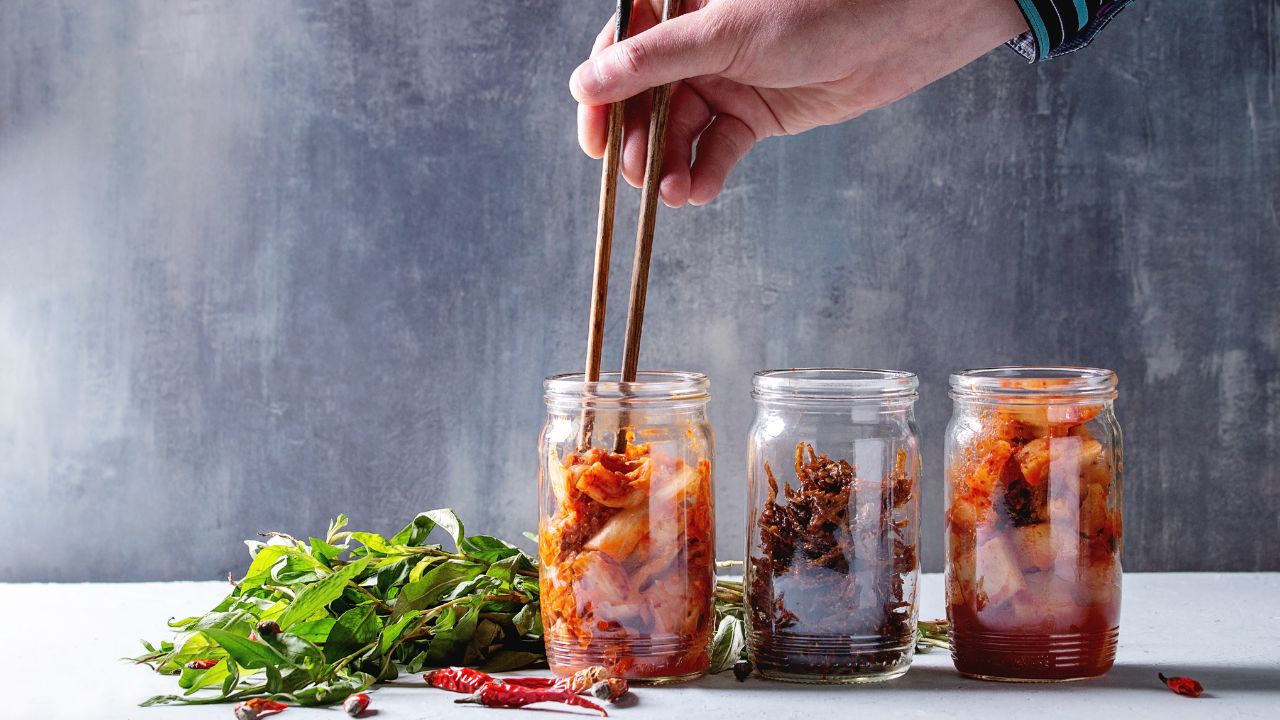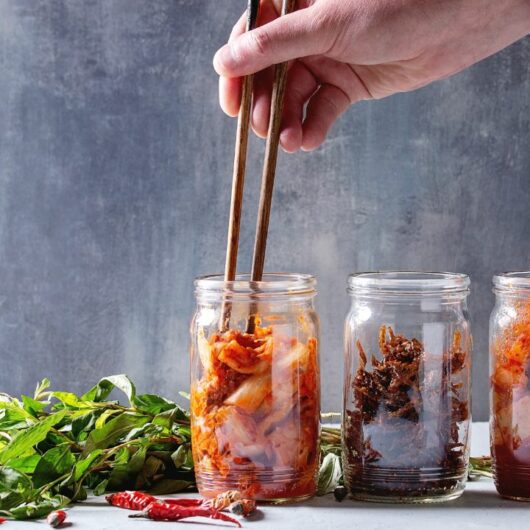South Korean culture has skyrocketed all over the world in the last few years or so, with elements such as Korean fashion, music, television, and movies rising to popularity in the West.
Another aspect of Korean culture that has become incredibly popular is the food, thanks to the wide range of flavors, the delicious nature of the dishes, and how they tend to be healthier options.

One particular kind of dish we are going to be looking at in this article is the Korean appetizer. Korean appetizers are also known as “banchan” or “bansang” in Korean, which refers to smaller side dishes that are served alongside larger dishes.
They are also commonly served alongside rice, though this isn’t always the case.
In this list, we are going to be looking at thirteen particular Korean appetizers that are able to be made at home. Let’s get started.
1. Gamjajeon (Korean Potato Pancakes)
You will notice that there are a few different kinds of pancakes on this list, as they are a popular choice of appetizer in Korea.
There are all sorts of different kinds of pancakes eaten as banchan in Korea, but we are kicking off with gamjajeon, which is a kind of Korean potato pancake.
Gamjajeon is a potato-based pancake that is made with only four ingredients, those being yellow russet potatoes, avocado oil, a cooking onion, and salt.
There is an optional sauce that you can make to accompany the pancakes, called gamjajeon sauce, which is a little more extensive in terms of ingredients.
To make gamjajeon sauce, you will need rice mirin, rice vinegar, soy sauce, a red chili, cane sugar, and a sprinkling of sesame seeds.
2. Kimchi (Spicy Pickled And Fermented Vegetables)
Kimchi is one of the most popular dishes to be found in Korea due to its traditional roots, with the earliest iterations of the dish being recorded as far back as the Silla dynasty, which lasted from 57 BC to AD 935.
Kimchi is commonly made from either Korean radish or Napa cabbage that is salted and fermented, but it tends to have a wide range of seasonings including ginger, garlic, spring onions, gochugaru (Korean chili powder), and jeotgal (salted seafood).
There are hundreds of varieties of kimchi available, but if you want to make some classic Baechu-kimchi for yourself, you will need Korean cabbage along with some radish, green onions, water, coarse salt, oysters, mustard leaf, and watercress.
3. Kimbap (Korean Seaweed Rice Rolls)
Highly popular in Korea, kimbap or gimbap might look like Japanese sushi, but they are very different in that they are made from rice tha has been seasoned with seasme rather than vinegar as weith sushi.
There are a range of fillings to be had with kimbap, such as fish, meat and vegetables. It also tends to be served alongside the aforementioned kimchi.
4. Pajeon (Korean Savory Pancakes)
Another tasty pancake dish, pajeon combines ingredients such as green onions and carrots to create some super tasty savory pancakes.
The great thing about these pancake dishes is that they are quick and easy to make, such as this pajeon recipe, which only takes fifteen minutes to prepare and twenty minutes to cook.
To create the pancakes themselves, you will need around eight scallions along with a lightly beaten egg, cold, sparkling water, all-purpose flour, salt, kosher salt, a carrot, peeled and grated garlic, sugar, vegetable oil, and cornstarch.
You can also make a delicious dipping sauce to go along with your pajeon, for which you will need garlic, rice vinegar, honey, toasted sesame oil, water, and low-sodium soy sauce. You can also throw in some red pepper flakes for a bit of spice.
5. Yachae-Hotteok (Korean Vegetable And Noodle Pancakes)
A popular Korean street snack, yachae-hotteok translates to “vegetable pancakes” in Korean, as yachae means “vegetables” and hotteok means “pancakes.”
Hotteok is usually a pancake that is stuffed with sweet ingredients alongside nuts, but this savory take on the dish stuffs the hotteok with chopped veggies and savory noodles.
The crunchiness of the yachae-hottoek crust combines beautifully with the fluffy inside of the pancakes, the crunchy vegetables fillings, and the soft noodles.
6. Haepari Naengchae (Jellyfish Salad)
Colorful, tasty and full of different textures, haepari naengchae features jellyfish as the main event, though it isnt overwhelmingly “fishy” in taste.
The mustard dressing of the salad creates a nice bite and works well with the jellyfish and the crab meat as well as the various veggies that go into the salat, such as Japanese cucumber and carrots.
7. Jjukkumi Guui (Spicy, Grilled Baby Octopus)
If you are a fan of seafood, then this next Korean appetizer is sure to be an option that interests you.
Many people are wary of cooking octopus, but with this jjukumi guui dish, the octopus becomes a lot easier to prep and cook.
This is due to the recipe using baby octopus rather than full brown octopus, which is much easier to manage and tender during the cooking process.
Jjukkumi guui marinates the octopus in a spicy gochujang sauce, offering a delicious combination of spice and seafood flavors.
8. Hobak Jun (Korean Fried Zucchini)
For a vegetarian-friendly Korean appetizer, hobak jun is an excellent choice. Hobak jun is simply fried zucchini, and it is not only versatile enough to go well with a range of different main dishes, but it is also super easy to make.
You only need five ingredients to make your own hobak jun, those being one medium or large zucchini, all-purpose flour, olive or vegetable oil, two large eggs, and kosher salt.
Some popular dishes that hobak jun is paired up with include bulgogi- Korean beef that is thinly sliced-, roasted fish, and all kinds of Korean soup (for more easy Korean soup recipes, read here).
9. Guljeon (Korean-style Oyster Fritters)
Oysters might not be to everyone’s tastes, but if you are a fan of them, then guljeon could be the Korean appetizer for you.
Guljeon is pan-fried and battered oysters that are popular due to the crispiness on the outside combined with the soft, textured oysters on the outside.
To make your own guljeon, you’ll need oysters and flour for the batter along with corn or potato starch, sesame oil, a carrot, two mushroom caps, a scallion, oil for frying, and baking soda.
10. Gochujang Honey Shrimp (Korean Spicy Shrimp)
If you like a bit of a kick to your sea food, then you are sure to enjoy this Korean gochunjang.
The dish is simply honey sesame shrimp with a nice, spicy warmth to it.
Lightly coated with seasoning and cornstarch before they are pain fried in oil and then coated with thick and flavorsome honey gochujang sesame soy sauce, gochujang honey shrimp is the perfect accompaniment to meat, fish or vegetable main courses.
11. Kimchijeon (Kimchi Pancakes)
This next take on the popular Korean pancake combines another appetizer that we mentioned earlier: kimchi.
Kimchijeon is a dish that is often eaten as a banchan due to the combination of the crispy pancake with the vinegary saltiness of kimchi.
To create your own kimchi pancakes, you’ll need scallions, yellow onions, garlic powder, eggs, coarse sea salt, Napa cabbage kimchi, and either potato starch, tapioca starch, and sweet potato starch.
12. Sangchu Geotjeori (Korean Lettuce Salad)
If you are looking for an appetizer that is all about veggies, then sangchu geotjeori could be the perfect appetizer for you to enjoy.
Sangchu geotjeori is a simple lettuce salad that is often used as an accompaniment to grilled meat in Korea.
Thanks to the simplicity of the dish, it is super easy to make for yourself at home. To make the salad itself, you’ll need a regular onion, a green onion, green or red leaf lettuce, and toasted sesame seeds.
For the dressing of the sangchu geotjeori, you’ll need some of those Korean chili flakes- gochugaru-, soy sauce, sesame seed oil, two minced cloves of garlic, apple cider vinegar, and sugar.
13. Dakgangjeong (Sweet And Crispy Korean Fried Chicken)
Last but not least we have dakgangjeong, a tasty crispy, and sweet Korean fried chicken dish. Fried chicken is a hugely popular dish in Korea, being used in main courses as well as in banchan such as with the dakgangjeong.
Dakgangjeong features crispy fried chicken that is glazed with a deliciously sweet, spicy, and sticky sauce. The recipe uses small, bite-sized pieces of boneless chicken to make for a perfect side dish.
To make your own dakgangjeong, you will need boneless and skinless chicken breast or thigh along with salt, pepper, rice wine, minced ginger and garlic, corn starch or potato starch, oil for frying, and milk.
The dakgangjeong sauce will need rice wine, soy sauce, apple cider vinegar, brown sugar, minced ginger and garlic, brown sugar, sesame oil, honey, pepper, and gochujang (though you can leave it out of the recipe if you would rather not have the spice).
Frequently Asked Questions
What Is The Most Popular Korean Food?
Though there are a wide range of popular foods to be found in Korea, the food that is likely to be acknowledge as one of the most well known and traditional is the aforementioned kimchi, due to the history that the dish has with the country and its versatility, able to be eaten in a huge amount of ways.
Final Thoughts
So there you have thirteen delicious Korean appetizers that you can try to make yourself at home.
Korean food has a strong connection to the culture of the country as a whole, so it is difficult not to feel like you are taking a bite out of the history of the country when you sample the cuisine!
Whether you have tried Korean cuisine before or not, you are sure to enjoy the taste of Korea that you will get when you snack on these appetizers.
- 15 Traditional Greek Breads - July 31, 2023
- 30 Delicious And Gluten-Free Cookie Recipes - July 29, 2023
- 30 Of The Best European Desserts - July 29, 2023

